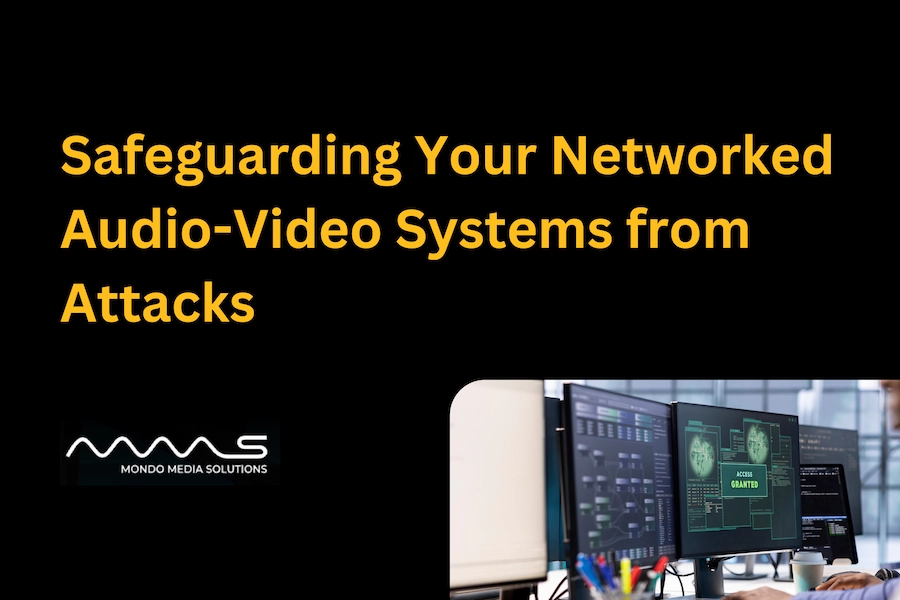In today’s connected workplaces, audiovisual (AV) technology touches everything from conference room solutions to cloud-based security cameras and even access control systems. That makes AV cybersecurity every bit as essential as protecting laptops or servers. If a threat actor compromises a smart display or rides in through a poorly secured camera, they can pivot deeper into your network. The upside: a handful of disciplined practices dramatically lowers the risk. Below, we focus on three areas—network security, data privacy, and secure remote access—that create a strong baseline for AV environments.
Network Security
Your first—and largest—defense surface is the network that your AV gear lives on. Treat it like critical infrastructure and design for containment and visibility.
- Network Segmentation
Place AV endpoints (projectors, codecs, DSPs, signage players, etc.) on their own VLAN or dedicated subnet instead of your general corporate LAN. Segmentation prevents easy lateral movement so that a flaw in one device doesn’t become a whole‑network incident. - Regular Updates
Keep firmware and software for AV devices current. Vendors routinely ship security fixes for streaming codecs, control processors, and camera OS images. A simple, scheduled maintenance window to apply patches closes many of the most common exposure points. - Strong Authentication
Replace default credentials at install time, enforce unique passphrases per device, and, where supported, enable multi‑factor authentication (MFA) on administrative consoles. Pair this with role‑based accounts instead of shared “installer” logins. - Active Monitoring
Watch the AV VLAN in real time. Baseline normal traffic patterns for conferencing and streaming, then alert on anomalies such as unexpected outbound connections, new services listening on management ports, or sudden spikes in multicast traffic.
Short, deliberate network planning during design pays long‑term dividends. By walling off and watching your AV stack, you substantially cut the blast radius of any single compromise.
Data Privacy
AV systems process sensitive conversations, presentations, and recordings. Treat that content with the same rigor you would apply to customer data or trade secrets.
Key steps to safeguard data privacy in your AV infrastructure include:
- Encryption
Enable encryption for data in motion (for example, TLS/SRTP for calls and control channels) and at rest (meeting captures, logs, and configuration backups). Confirm these features are actually turned on in each platform—not just available. - Access Control
Tie AV management to centralized identity (e.g., SSO/Directory) and assign least‑privilege roles. Limit configuration changes to admins, and restrict access to recordings or live streams to approved groups only. By tying your AV gear into your broader user directory or access control systems, you ensure that only the right people have the right level of access. - Privacy by Design
When implementing new AV solutions, choose hardware and software that prioritize privacy. Favor hardware and software that include privacy‑forward defaults: password‑protected streams, camera/microphone disable switches, on‑device indicators when media is active, and compliance options that align with your industry. - Physical Security
Secure racks, closets, and patch panels that house encoders, switches, and control processors. Physical tampering is still one of the fastest ways to plant rogue devices or extract configs.
By elevating controls around the data your AV estate touches, you build trust with users and partners while reducing legal and reputational risk.
Secure Remote Access
Remote management is incredibly convenient—and a common attack path if it’s not tightly governed. Lock it down with layered controls.
- Use VPNs for Remote Connections
Require administrators and trusted vendors to reach AV management interfaces through a VPN or secure access gateway, not directly from the public internet. This creates an encrypted path and limits who can even see those interfaces. - Enforce MFA on Logins
Apply multi‑factor authentication to all remote access and cloud portals tied to AV systems. Even if a password leaks through phishing, MFA adds the extra proof an attacker is unlikely to have. - Adopt a Zero Trust Approach
Assume every request is untrusted until verified. Check user identity, device health, and context (location, time, risk) before granting access—whether the request originates inside your office or from home. - Employee Training
People remain a favorite target. Provide short, recurring training on secure passwords, recognizing phishing, and avoiding public Wi‑Fi for admin tasks. Publish a quick‑start checklist for anyone who touches AV systems remotely.
Locking down remote pathways removes one of the biggest breach causes: simple misconfigurations or risky habits during off‑site administration.
Staying Proactive and Secure
Security is a practice, not a project. By implementing the network, data, and access controls above, you establish a durable defense for modern threats—without sacrificing usability. If you’re unsure where to begin or want to validate your design, consider engaging professional AV integration services to review and harden your deployment. Building security in from day one keeps your AV environment reliable, resilient, and ready for whatever comes next.
